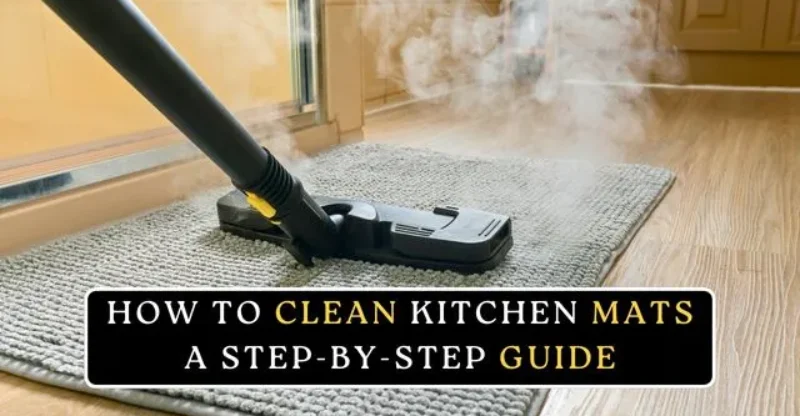How to Clean Kitchen Mats: A Step-by-Step Guide
Kitchen mats are an essential item in any home, providing a comfortable and supportive surface to stand on while cooking or doing dishes.
However, with all the spills, splatters, and foot traffic that occurs in the kitchen, these mats can quickly become dirty and grimy. That’s why regular cleaning is crucial to maintain their appearance and ensure their longevity.
In this article, we’ll take you through the process of cleaning kitchen mats, covering everything from basic maintenance to deep cleaning methods.
So, if you’re tired of seeing a dull and dirty mat every time you step into your kitchen, read on to learn how to restore its cleanliness and beauty.
Note: This website is supported by readers and if you click on our links we may earn a commission and as an Amazon Associate, we earn from qualifying purchases.
Gather Your Supplies
First and foremost, you’ll need a few basic supplies to get started. Begin by emptying your sink and ensuring you have access to warm water.
Grab a gentle dish soap, a sponge or scrub brush, and a clean cloth or towel. If your mats are particularly dirty or stained, you may also want to have some baking soda on hand for an extra cleaning boost.
1. Shake Off Excess Debris
One simple way to get rid of excess debris on your kitchen mats is to shake them off regularly. Take your mat outside, hold it at one end, and give it a few vigorous shakes.
This will help dislodge any loose dirt, food crumbs, and other debris that may have accumulated. It’s a quick and easy way to keep your mat looking and smelling fresh.
Another handy method is to use a broom or a brush to sweep off the excess debris. Simply sweep in one direction, starting from the center of the mat and working your way towards the edges.
This method is especially useful for mats with a textured surface as it helps to dislodge dirt from the nooks and crannies. Thoroughly sweep both sides of the mat to ensure you’ve removed all the debris.
You can also vacuum your kitchen mats to remove any loose dirt and debris. Use the upholstery attachment or a handheld vacuum for better control.
Start at one end of the mat and use long, smooth strokes to cover the entire surface. If your mats are machine-washable, you can also run them through a gentle cycle in the washing machine following the manufacturer’s instructions.
2. Pre-Treat Stains
Nobody likes dealing with stains, especially when they show up on our favorite clothes or household items.
But instead of panicking and throwing everything away, it’s important to know how to properly pre-treat stains.
One item that often encounters stains in the kitchen is kitchen mats, which can easily become dirty and stained from spills and food droppings.
If you notice a stain on your kitchen mat, act quickly. Blot the stain with a clean cloth or paper towel to remove any excess liquid.
Avoid rubbing the stain, as it can cause it to spread further. Apply a stain remover or pre-treatment solution to the affected area and let it sit for a few minutes to penetrate the stain.
3. Scrub with a Gentle Cleaner
If you want to keep your kitchen mats clean and looking fresh, it’s important to use a gentle cleaner that won’t damage or weaken the material.
Prepare a solution of warm water and mild dish soap. Avoid using strong detergents or bleach as they can fade the color of your mats or even cause them to deteriorate.
Dip a soft cloth or sponge into the soapy water and gently scrub the mats, paying extra attention to any stains or high-traffic areas.
Make sure to rinse the mats thoroughly with clean water to remove any soap residue. Once clean, pat them dry with a towel or hang them up to air dry completely.
4. Rinse Thoroughly
Take the kitchen mat outside or to a suitable area where you can rinse it with water. Use a garden hose or a high-pressure sprayer to thoroughly rinse the mat.
Start from one end and work your way to the other, making sure to cover all areas. Pay special attention to corners, edges, and any grooves in the mat where dirt can accumulate.
After rinsing, gently scrub the mat with a soft brush or sponge to remove any remaining stains or stubborn dirt. This step helps to ensure that the mat is thoroughly cleaned.
Once done, rinse the mat once again to remove any soap residue or cleaning agents. Finally, allow the mat to dry completely before placing it back in your kitchen.
5. Dry Completely
Keeping your kitchen mats clean and free of moisture is crucial for maintaining a clean and safe kitchen environment.
Wet mats can become breeding grounds for bacteria and can pose a slipping hazard. To ensure that your kitchen mats dry completely, follow these simple steps.
Allow the mats to air dry in a well-ventilated area. Avoid drying them in direct sunlight, as this can cause the material to fade or become brittle over time. Instead, place the mats on a clean and dry surface, such as a rack or a clean kitchen towel.
If you need to speed up the drying process, you can also use a fan or a dehumidifier to remove excess moisture from the mats.
This will help prevent any lingering dampness that could attract mold or mildew. Just make sure to position the fan or dehumidifier at a safe distance to avoid damaging the mats.
6. Maintain a Regular Cleaning Routine
In addition to regular cleaning, it is also important to schedule deep cleaning sessions for your kitchen mats.
This can be done by either using a steam cleaner or by soaking the mats in a mixture of warm water and vinegar.
Steam cleaning is a quick and effective method that kills bacteria and removes dirt from deep within the mat’s fibers.
If you prefer soaking the mats, combine equal parts of water and vinegar in a large container, and let the mats soak for at least an hour. This natural solution will help to disinfect and deodorize them.
7. Store Properly for Longevity
Once your kitchen mats are clean and dry, it’s time to store them properly. Folding or rolling them is generally not recommended, as it can cause creases or cracks in the material over time.
Instead, consider hanging them on a hook or rolling them around a tube to maintain their shape. Additionally, storing them in a cool and dry place away from direct sunlight will help prevent fading or discoloration.
Conclusion
By following these simple steps, you can ensure that your kitchen mats remain clean, fresh, and free from harmful bacteria. Remember to clean the mats every week and schedule deep cleaning sessions at least once a month.
With a little effort and consistency, your kitchen mats will continue to provide a clean and comfortable surface to work on, contributing to a healthier and more enjoyable cooking experience.
FAQs
Yes, you can wash a kitchen mat using mild detergent and water. Follow the cleaning instructions provided by the manufacturer for the best results.
Anti-fatigue kitchen mats are designed to reduce fatigue and discomfort caused by standing for long periods. They provide cushioning and support, making them ideal for use in kitchens and other areas where people stand for extended periods.
Some popular options include the Kangaroo Original Standing Mat, Sky Solutions Anti-Fatigue Mat, and Amazon Basics Premium Anti-Fatigue Mat.



